by Lisa Cooke | Jul 23, 2016 | 01 What's New, Findmypast, Records & databases |
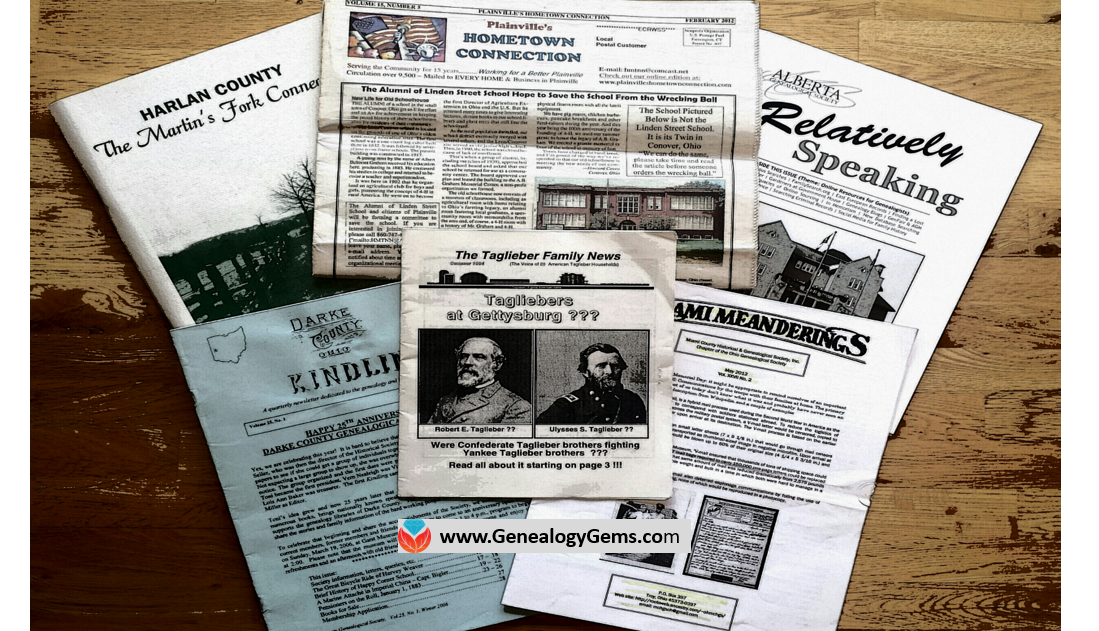
Have you met PERSI? You should! PERSI is the Periodical Source Index. Use PERSI for genealogy and you may discover your ancestors in thousands of articles you never knew existed.
You may have heard me talk in the past about PERSI. In case you haven’t…PERSI is not a person—it’s the acronym for the Periodical Source Index. PERSI is THE master index for periodicals with over 2.7 million entries. Thousands of magazines, newsletters, journals, and other periodicals from the U.S., Canada, Britain, Ireland, and Australia are indexed here.
PERSI is maintained by the Allen County Public Library’s Genealogy Center in Fort Wayne, Indiana. They have the equivalent of 6 full-time staff who are dedicated to subject-indexing every issue of every known genealogy or historical periodical and even the tiniest society newsletter.
Curt Witcher, who runs the Genealogy Center at Allen County and who has been a guest on the podcast in the past, estimates that if you don’t consult periodicals in your research, you could be missing up to 30% of your research leads! That’s a lot of leads! PERSI has long been a staple resource for advanced and professional genealogists to help them break through brick walls. With its help, you can much more quickly locate articles like biographical sketches of ancestors (or people they knew), transcribed indexes to naturalization or probate records, church records, school records, and the like. There might be just-what-you-need histories of places or the organizations your ancestors belonged to.
These key articles are often buried so deep in back issues of little local genealogy newsletters that you may never come across them on your own. Sometimes, they’re what we call “orphaned” content: articles we’d find in totally unexpected places.
HOW TO SEARCH PERSI ONLINE
PERSI used to be searchable on Ancestry, but it isn’t there anymore. The current version of PERSI is exclusively on Findmypast and they’re doing something really cool with it: they are gradually adding digitized articles to the index! They are doing this by signing contracts with each individual society or journal publisher, so it’s not a fast process. The vast majority of entries on PERSI do not have digitized articles linked to them yet. It’s a bonus when you do find them.
To search PERSI at Findmypast you do not actually need a subscription. They allow anyone to search and see the list of results. To see details about specific search results (including any digitized images), you will need a subscription OR you will need to purchase their pay-per-view credits. Findmypast does offer a 14-day free trial. You can also use Findmypast at Family History Centers and at many libraries that have institutional subscriptions.
Once you have located an article, it’s inexpensive to order a copy directly from the Allen County Public Library Genealogy Center. Simply download the order form PDF from their website, fill it out, and mail it in. Last we checked, you can request up to six articles for only $7.50, which you pre-pay and then they bill you separately for copies at 20 cents per page.
Sometime soon, why not take 15 minutes—or your next lunch break at work–and search PERSI for your top surnames and locations? Again, the database is PERSI, it is at Findmypast, and the chance to discover is all yours.
MORE GEMS ON PERSI
PERSI Digitized Collections Gaining Ground
New FindMyPast Hints Help Find Records
The Genealogy Gems Podcast Premium Episode 135: Comparsion of Google Scholar & PERSI (Premium Member Subscription Needed)
by Lisa Cooke | Mar 27, 2017 | 01 What's New, RootsMagic
Merging duplicate records in your family tree is important. Perhaps you have inherited a giant genealogy file (GEDCOM) from a relative. What now? Follow along in our series on Inherited Genealogy Files as we talk about how to merge the duplicates in your family tree.
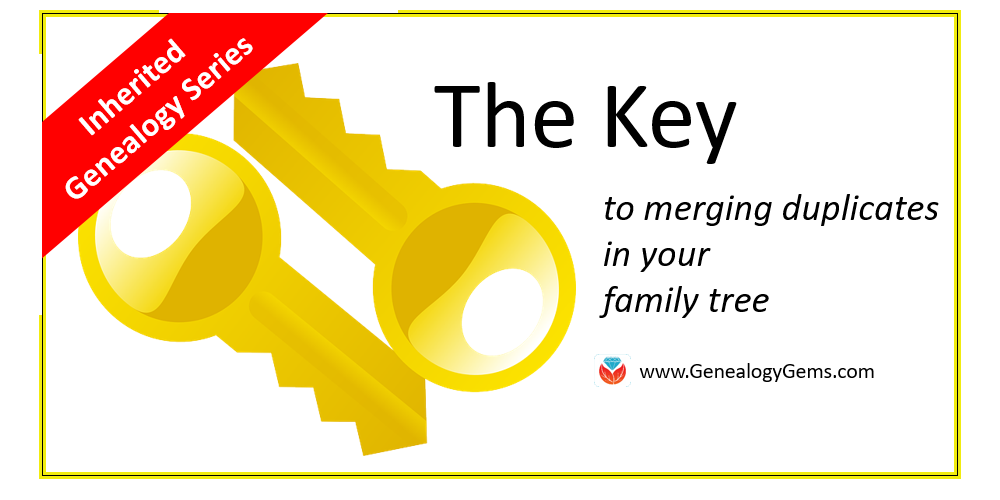
Have you cleaned up your family tree lately? Whether you have inherited a genealogy file from a relative or have been an avid researcher yourself, clean-up is necessary from time to time, especially as your database grows.
Merging Duplicates from an Inherited Genealogy File with RootsMagic
When you sit down to do your genealogy research, the last thing you want to worry about are duplicate names. Duplicates can be distracting and confusing.
You may have inherited a genealogy file or files in the form of GEDCOMs. (Read more on what and how to use a GEDCOM file here.) While inheriting this family history is great, it can also be a lot of work to clean-up, confirm the data, and add source citations where needed.
If you use RootsMagic or other similar software, it can be quick and easy to clean up duplicate names in your database. Start by running a duplicate search by clicking on Tools, selecting Merge, and then clicking Duplicate search merge.
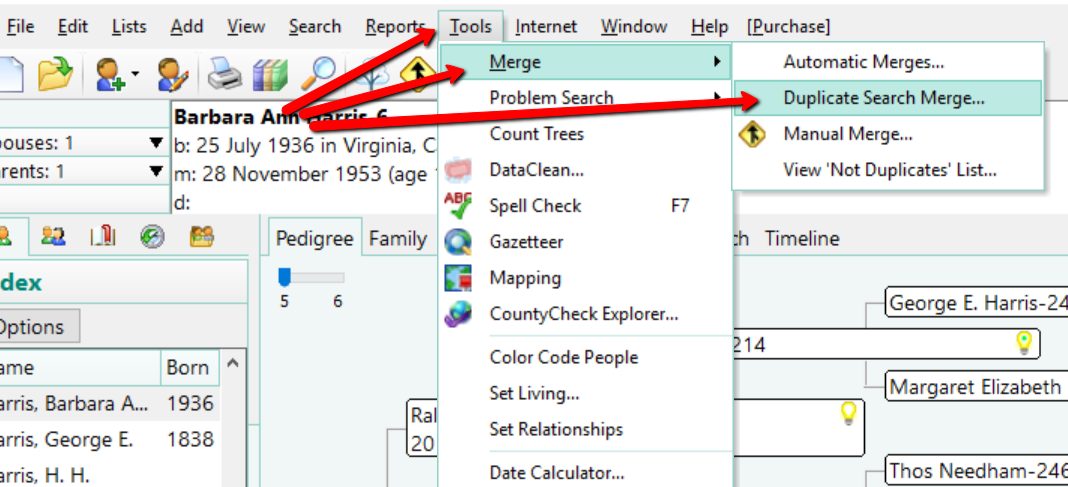
You can search for duplicates by surname or given name. You might consider running a duplicate search for sounds alike, as well. This is particularly important if you have merged two databases in which you and the other contributor may have used different surname spellings.
When you are ready, click Search for duplicates at the bottom of the box. The system will tell you how many duplicates it finds and allow you to compare them one-by-one.
If you find a duplicate, the primary person will be on the left and the matching record on the right. Whichever record/person is most correct, use the Swap button to move that record to the primary position on the left.
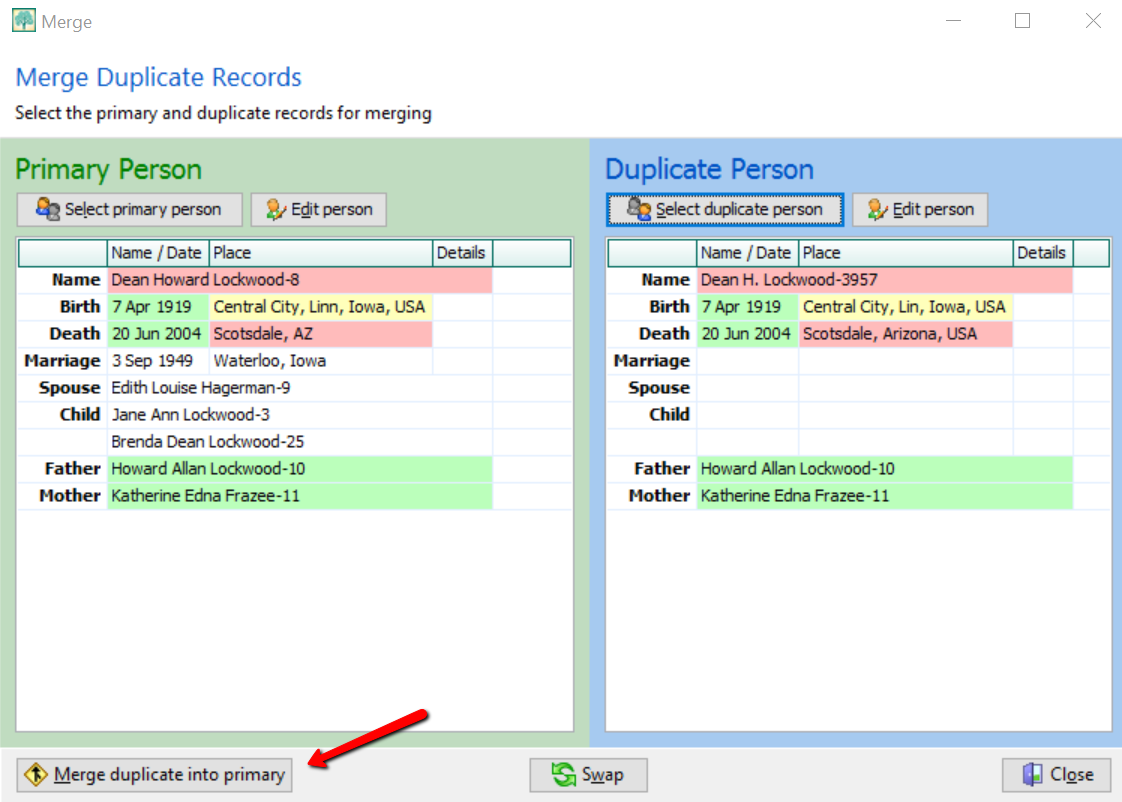
If you feel these are a match, click Merge duplicate into primary at the bottom left corner. You have now merged these two individuals. It should be noted that you do not actually lose any of the data of the duplicate person. If I find Dean Howard Lockwood in my index and double click on his name, a pop-up window appears and I see he now has two birth and death entries, however. To fix this, click on the duplicate fact to highlight it, then click Delete fact at the top.
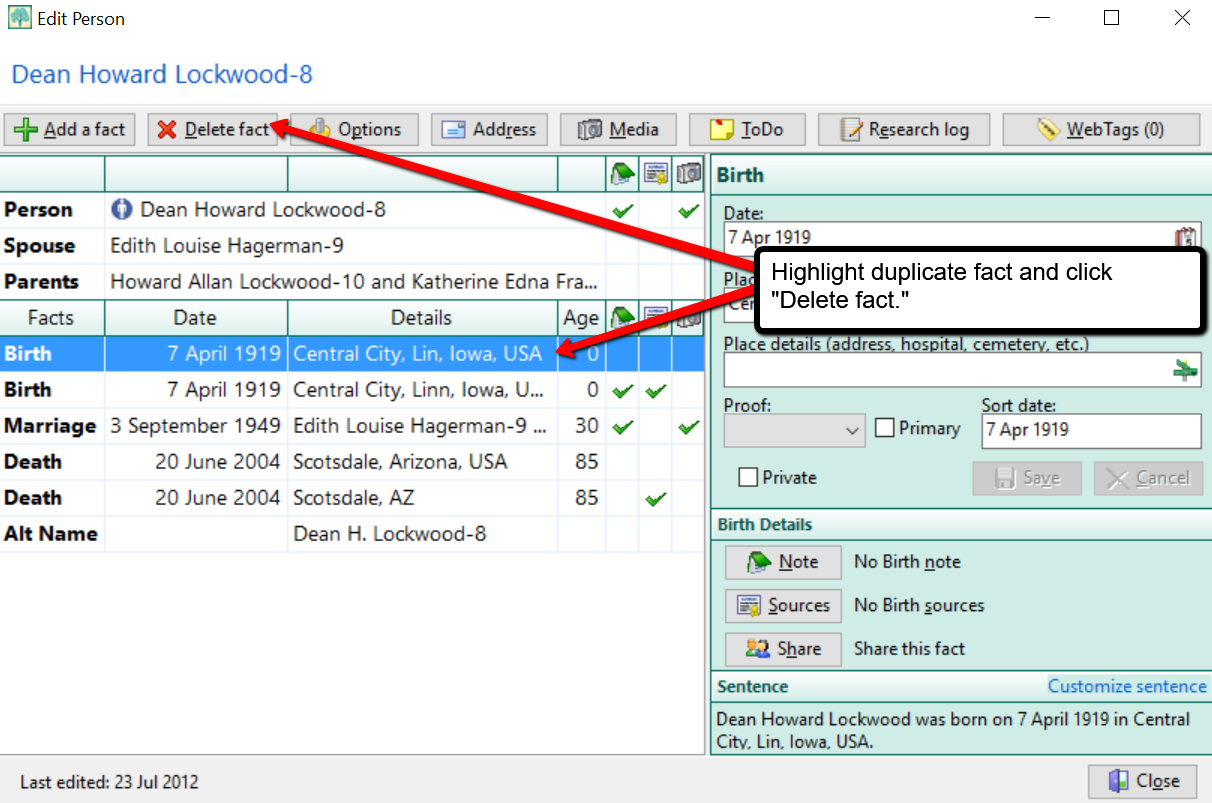
Cleaning Up Duplicate Places
You may not have considered cleaning up the duplicate places that exist in your file. For example, perhaps Great-aunt Susie liked to use the old format for place names. [i.e. , Ross County, Ohio] Notice the comma before the county name Ross. This was the way in which genealogists used to indicate Ross was the name of the county. Now, we use the more recent accepted format and change that to: Ross county, Ohio, United States. You can quickly merge these two places into one by clicking Lists at the top left, and choosing Place List.
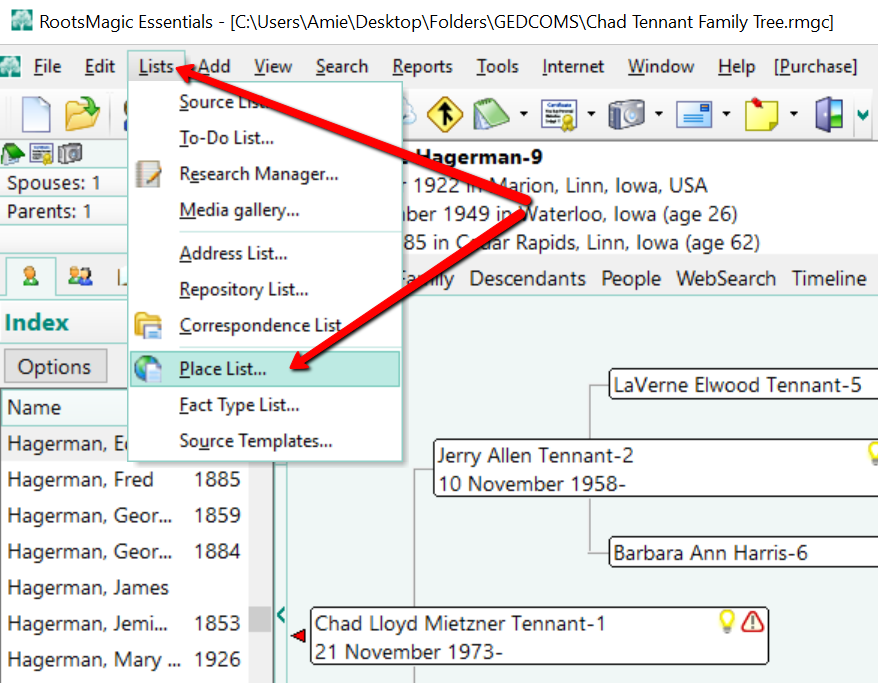
Now, choose the place you would like to fix and double click it. In the pop-up window that appears, simply type in the place name as you desire it to appear in your database.
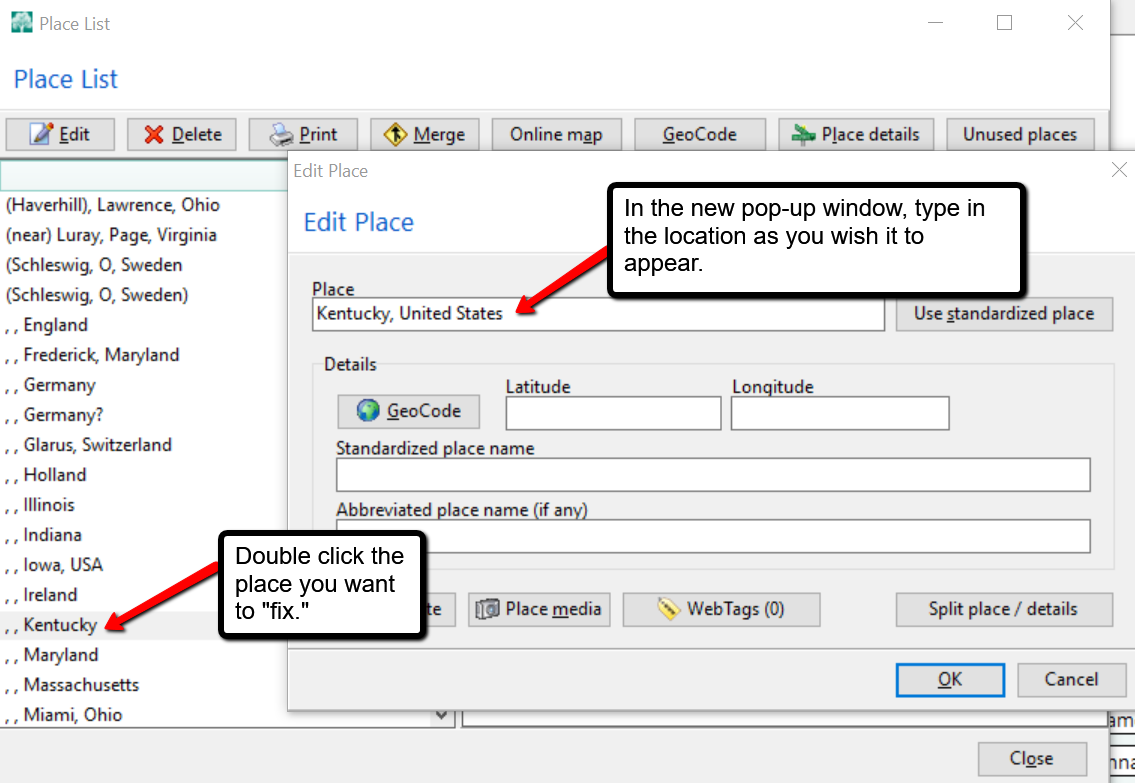
In the example above, we have changed , , Kentucky to Kentucky, United States and clicked OK. But wait, there’s one more step! You may notice your list now shows duplicates of Kentucky, United States or some variation. To fix that problem, click on the merge button at the top of the Place List pop-up window. A new window will pop-up and you can choose all the places you wish to merge together. Then, click Merge selected places.
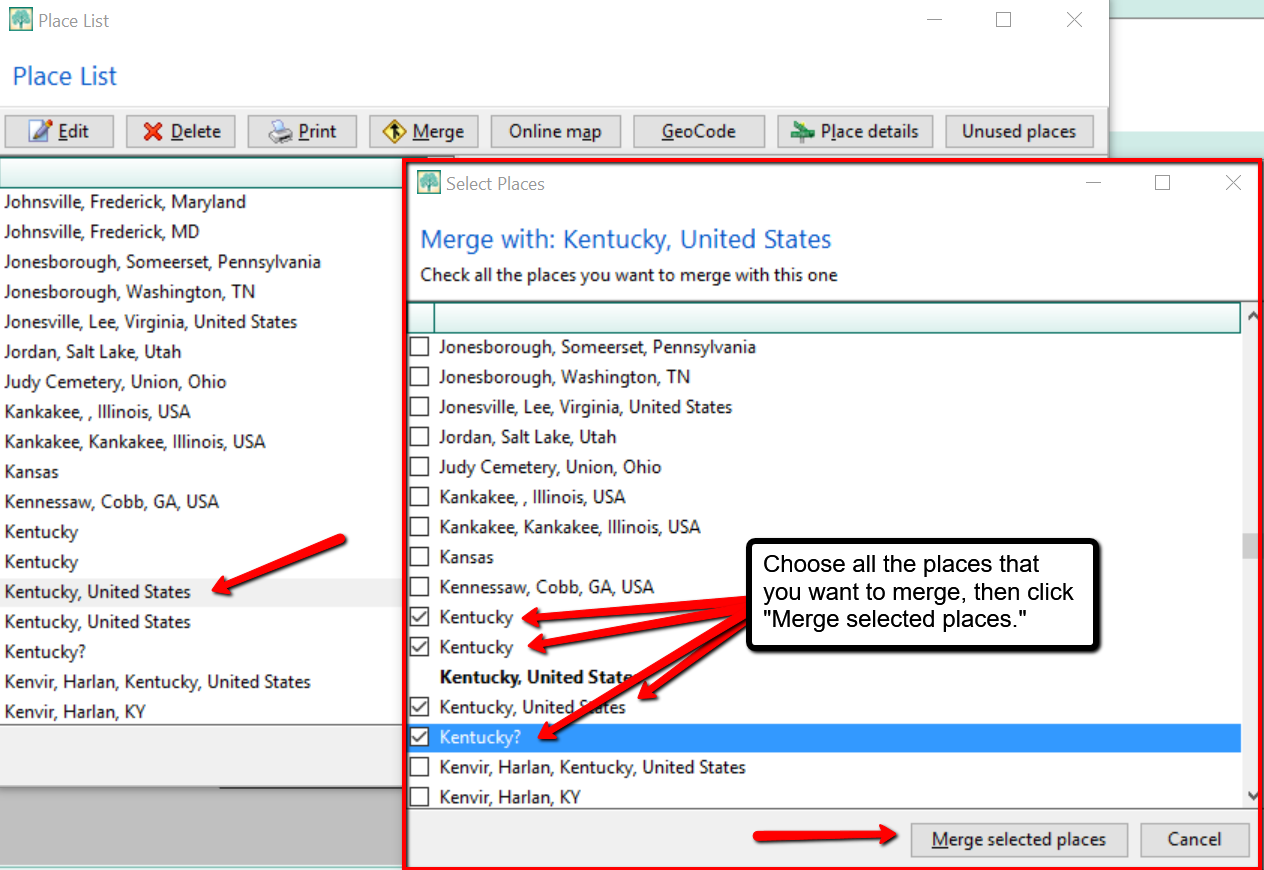
More on RootsMagic Software
RootsMagic is the genealogy software used and recommended by Lisa Louise Cooke and The Genealogy Gems Podcast. You can purchase this amazing software from the Products We Love tab in our store or by clicking on the RootsMagic 7 image link. When you use our affiliate links, you are helping to support the free Genealogy Gems Podcast. Thank you!
is the genealogy software used and recommended by Lisa Louise Cooke and The Genealogy Gems Podcast. You can purchase this amazing software from the Products We Love tab in our store or by clicking on the RootsMagic 7 image link. When you use our affiliate links, you are helping to support the free Genealogy Gems Podcast. Thank you!
by Lisa Cooke | Jun 9, 2017 | 01 What's New, British, Records & databases, Scottish Genealogy
Got ancestors from England, Scotland, Wales or Northern Island? Check out these new UK genealogy records online: 1939 Register updates; newspapers; Scottish postal directories and local resources for Derbyshire and the city of York.
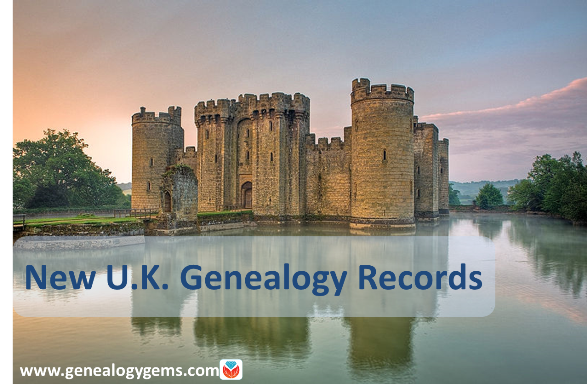
Featured Update: Additions to the 1939 Register online
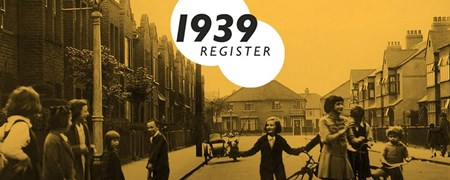 Over 660,000 new records pertaining to empty, uninhabited addresses across England and Wales have been added to Findmypast’s unique and important online 1939 Register resource.
Over 660,000 new records pertaining to empty, uninhabited addresses across England and Wales have been added to Findmypast’s unique and important online 1939 Register resource.
We asked Jim Shaughnessy at Findmypast how these records can help a researcher. “There are a few things that an empty address can tell you,” he responds. “Knowing the house you are looking for was an empty address in 1939 may help you to direct further research. As with other record sets, the occupations of the neighbors can give you an idea of the area (in terms of the largest local employer).”
The ability to search even vacant addresses “can also give you information about areas [later] destroyed by aerial bombing during the War (and during the extensive regeneration in the decades following),” writes Jim. “The Register was compiled September 1939; bombing began in 1940 and a lot of houses wouldn’t have been rebuilt, particularly in impoverished areas where we had bombsites for years and years afterwards. So from that you could look at how the War changed that area or that street: what doesn’t exist now but did pre-Blitz.”
Jim also pointed out that “Findmypast is the only site on which you can search by address on the 1911 census as well as the 1939 register, plus we have the largest collection of electoral rolls, also searchable by address. You can search by address and then build the entire picture of what your family did.”
More UK Genealogy Records Now Online
U.K. Newspapers
The British Newspaper Archive recently added four new titles: the Willesden Chronicle, published in London and the Warrington Guardian, published in Cheshire; the Dudley Herald [Dudley, West Midlands, England] and the Monitor, and Missionary Chronicle, of the Reformed Presbyterian Church in Ireland [Belfast, Northern Ireland]. The British Newspaper Archive now holds over 19.5 million pages of historic newspapers dating from the early 1700s to the early 2000s!
In addition, Findmypast has added over 186,000 records to its collection, Sussex, Eastbourne Gazette Newspaper Notices. “This indexed collection includes names found in the paper’s family notices section (announcements of births, marriages, and deaths) as well as other reports on events such as divorces, murders, tragedies, shipwrecks, lynchings, and paternity cases. The newspaper reported on stories in Sussex, but also internationally.”
Derbyshire, England. Over 800 records have been added to Findmypast’s unique collection of Derbyshire Hospital Admissions and Deaths 1855-1913. “The collection now contains over 5,000 records taken from two different sources: Derbyshire Royal Infirmary, Deaths 1892 – 1912 and Victoria Memorial Cottage Hospital, Ashbourne Admissions 1899 – 1913,” states an announcement. “Each record includes a transcript produced by the Ancestral Archives of Derbyshire. Records can include the patient’s admission date, reason for admission, condition after admission, marital status, residence, rank or profession, date of discharge or death, and cause of death.” Looking for other Derbyshire ancestors? Click here to read about online Methodist records for Derbyshire.
York, England. A new Findmypast resource, The York Collection, includes nearly 300,000 genealogical records documenting over 600 years of residents of the city of York. A press release calls it “the largest online repository of historic City of York records in the world….Fully searchable transcripts of each original document are also included, enabling anyone to go online and search for their York ancestors by name, location, and date.”
The collection is comprised of a variety of fascinating documents, including hearth & window tax records (1665-1778); lists of apprentices and freemen (1272-1930); city of York trade directories; electoral registers (1832-1932), city of York school admission registers; city of York deeds registers (1718-1866); city of York militia & muster rolls (1509-1829), and city of York calendars of prisoners (1739-1851). This collection was published in partnership with Explore York.
Scotland Directories
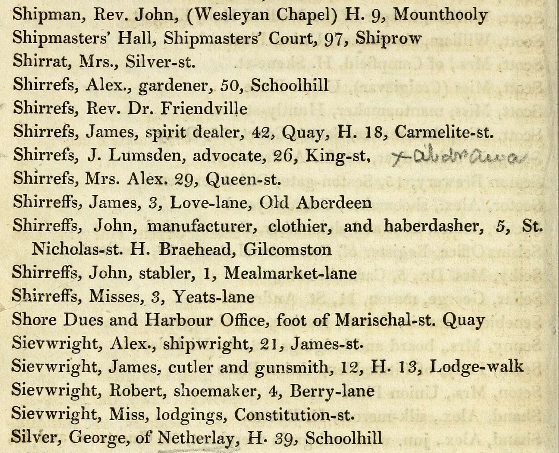
A snippet from an 1820s post office directory for Aberdeen and vicinity. Image on Findmypast.com.
Over 180,000 new record images have been added to Findmypast.com’s collection of Scottish post office directories, now spanning 1774-1942. The collection has nearly 900 browse-only volumes of directories that offer descriptions of Scottish towns along with lists of residents by occupation and address.
Here’s a little background from Findmypast: “Post directories are an excellent source for family historians wanting to trace ancestors on a yearly basis. Directories allow you to fill in the gaps between the census records. They can also provide vital information about your ancestor’s residence, which can lead to the discovery of more records….Directories can add historical context to your ancestor’s story. Directories will give you a better understanding of where your ancestor lived, such as how many businesses were in the town, how many schools, what day was the market day, and how big was the town.”
“Directories may focus on a particular town or district or you can find national postal directories. The majority of post directories comprise a description of the place, along with lists of people by occupation. For example, you will find lists of magistrates, councillors, sheriffs, police officers, and merchants. It is important to remember that post directories are not complete lists of all the residents in the town or county. Also, many directories fail to include women.”
TIP: A browse-only collection of digitized Scottish post office directories for 1773-1991 is available to search for free online at the National Library of Scotland.
Start researching your English ancestors with this free two-part article series:
 British Research for Beginners (“English” v. “British” and more)
British Research for Beginners (“English” v. “British” and more)
English Parish Records: Finding English Ancestors Before 1837
by Lisa Cooke | Jul 2, 2019 | 01 What's New, Records & databases |
Genealogical records come in all shapes and sizes and this week’s records round up even includes round records! Keep reading because you never know what you’ll find.
Photographs at Indiana Album
I love this website simply for the tag line Historic Photographs from the attic to the Web! We all have a bit of other families’ genealogy in our attics, closets and scrapbooks, and Indiana Album is a nonprofit organization that want to make it accessible. They encourage Hoosiers (and of course descendants of Hoosiers) to loan them their photos and documents. The group then digitizes, catalogs and shares them in a database on their website. Head here to search for the names, places and other keywords relating to your family. I’m finding gems like the one below.

Internet Archive’s Great 78 Project
Here’s a free online collection that is adding tons of new melodic content!
I’m amazed how often I run across music references in my genealogical research, particularly when reviewing the diaries, letters and other records of my late 19th century and early 20th century relatives.
When I was in my twenties I wrote my Grandfather often and asked him questions like “Do you remember any favorite songs from when you were a young man?” His answer included:
As you can see from the linked titles above (click them to listen for yourself), I found every single one of them at the Internet Archive’s Great 78 Project. This is a phenomenal free online collection of digitized recordings made accessible to everyone.
The good news is that the project, which currently boasts over 200,000 recordings, just received funding to preserve another 250,000 sides of 78 rpm records. That means they need records. So, check your basement, closets and attic and consider donating your 78s to the Internet Archive’s Great 78 Project for digitization and physical preservation. You can donate your 78rpm Records to the Internet Archive’s Great 78 Project here.

No Wonder (That I Love You) Gene Austin, 1925
UK & Iceland Records at Findmypast
There are over 6.4 million new records and newspaper articles available to search and explore this Findmypast Friday including over 264,000 new and exclusive parish records that have been digitised and made available online for the first time in association with the Lancashire Archives.
Lancashire Baptisms
Over 31,000 additional records are now available to search amongst out collection of Lancashire Baptisms. The new additions cover the parishes of:
- Edge Hill, St Nathaniel -1869 to 1918
- Liverpool, St John – 1785 to 1898
- Liverpool, St Silas, Pembroke Place – 1841 to 1918
- Liverpool, St Stephen the Martyr – 1851 to 1918
- Newburgh, Christ Church – 1860 to 1917
- Seaforth, St Thomas – 1839 to 1918
- Stoneycroft, St Paul – 1916 to 1918
- Toxteth Park, St Bede – 1882 to 1918
These records include both transcripts and images of the original documents. Each result will reveal when and where your ancestor’s baptism took place, the names of their parent’s and father’s occupation.
Lancashire Marriages & Banns
A further 179,000 records have also been added to our collection of Lancashire Banns & Marriages. These new marriage registers add coverage for a selection of new Liverpool parishes, including:
- Edge Hill, St Nathaniel – 1871 to 1943
- Everton, Emmanuel – 1835 to 1943
- Liverpool, St John – 1785 to 1898
- Liverpool, St Stephenn the Martyr – 1852 to 1943
- Seaforth, St Thomas – 1870 to 1943
- Stoneycroft, St Paul – 1916 to 1943
- Toxteth Park, St Bede – 1887 to 1943
Learn when, where and to whom your ancestor was married, as well as the happy couple’s ages, occupations, marital status, residences, parent’s names and father’s occupation.
Lancashire Burials
Over 54,000 new records from the central Liverpool Parish of St John. These new records span the years 1767 to 1883 and will allow you to discover when your Liverpool ancestors were laid to rest.
The transcripts and images within this collection will enable you to discover when your ancestor died, their occupation, the date and location of their burial, as well as their age at death.
United States Obituary Notices
A whopping 5.7 million new records are now available to search within our collection of United States Obituary Notices.
These records, obtained from the tributes.com and currentobituary.com websites will enable you to discover your ancestor’s name, birth and death years as well as the original obituary text. Additional information such as images and details about the records can be found on the source’s website.
Scotland, Darien Scheme Investors 1696
Explore the records of investors in The Company of Scotland Trading to Africa and the Indies, also called the Scottish Darien Company. It was funded by investments from people across Scotland. These transcripts will provide you with information on those who invested money and their representatives.
The Darien scheme was an unsuccessful attempt by the Kingdom of Scotland to establish a colony called “Caledonia” in Panama in the late 1690s. Opposed by commercial interests from England, the company of Scotland raised subscriptions for the scheme in Amsterdam, Hamburg, and London. English investors soon raised their share but withdrew their money after King William and the English Parliament turned against the venture. However, by August 1696 the Scottish investors raised £400,000 themselves.
As the scheme was backed by approximately 20% of all the money circulating in the country at the time, its failure left the entire Lowlands in substantial financial ruin and was an important factor in weakening Scottish resistance to the Act of Union. In July 1699, the colony was abandoned due to inadequate provisions, the unfamiliar hot and humid climate had caused fever to spread, and many settlers died. Of the 1,200 settlers, only 300 survived.
International Records Update – Iceland
To mark Icelandic National Day this week, we have made over 287,000 baptism and marriage records from the land of fire and ice available to search on Findmypast.
These two new indexes span the years 1730 to 1920 and will generate hints against your Findmypast Family tree.
British & Irish Newspaper Update
A bumper crop of new and updated titles have been added to the collection this week, with 163,404 new pages added. We have seven brand new titles added this week, covering both England and Scotland. We have three new London publications joining us – the Harrow Midweek, the Middlesex Gazette and the Middlesex Independent – as well as one Scottish title (the Northern Ensign & Weekly Gazette) and one new Essex title (the Essex Guardian). We are also delighted to welcome two specialist sporting titles – namely, the Volunteer Record & Shooting News, which ‘warmly supports the interests of the shooting man,’ and the Fishing Gazette, a publication which covers all types of fishing across the world.
Further to these new arrivals, we have also updated sixteen of our existing titles. Updates this week cover the length and the breadth of the United Kingdom and Ireland, with updates incorporating publications from Aberdeen to Jersey, from Kingston to County Down, from Bristol to Kensington, from Crawley to Strabane.
Navy Officer Letters at Fold3
Fold3 just announced “We have added a new collection of naval records to our archives! The Navy Officers’ Letters 1802-1884 is a collection of letters to the Secretary of the Navy from officers assigned to naval ships, stations, and Navy bureaus.
The letters contain routine personnel matters such as duty assignments, leave or furloughs, desertions, resignations, court-martials, and other administrative issues. The collection is organized by year and then alphabetically by sender. The letters offer a glimpse into military history and provide valuable genealogical records for ancestors that served in the Navy.”
British Newspaper Archive
This week the British Newspaper Archive added 137,896 new pages spanning 128 years from 1871 to 1999 to eighteen of their existing collections. These include extensive updates to the Walsall Observer, and South Staffordshire Chronicle, which cover the years 1873 to 1969 and includes nearly 35,000 pages.
Also updated: Six of their London titles, including the Acton Gazette, as well as three Scottish titles, with pages added to the Hamilton Advertiser, the Dumfries and Galloway Standard and the Aberdeen Press and Journal. We have added pages to publications covering Newcastle and Middlesbrough, as well as new pages to The People.
A subscription is required. Clicking on the titles above allows you to see examples and review the scope of the collection.
Full Disclosure: We appreciate when you use our links because if and when you subscribe we are compensated, which helps support this free blog and the free Genealogy Gems Podcast.
by Lisa Cooke | Dec 22, 2023 | 01 What's New, Immigration, United States |
VIDEO & SHOW NOTES: Discover how to search for ancestors who may be included on the Ellis Island Immigrant Wall of Honor, and learn how you can honor ancestors’ by adding them to the list.
Watch Now:
Resources:
Download the ad-free Show Notes cheat sheet for this video here. (Premium Membership required.)
Show Notes: Ellis Island Wall of Honor
Millions of our ancestors came through Ellis Island in New York. Mine certainly did. So it’s a great place for genealogists to explore and learn new things about their family history. Well, there have been some changes and things happening over at the Ellis Island Foundation. And here to tell us more about it is Suzanne Mannion. She’s the Director of Public Affairs have the Statue of Liberty Ellis Island Foundation.

The American Immigrant Wall of Honor-Courtesy of Paul Seibert Photography
About the Ellis Island Wall of Honor
From Suzanne: The American immigrant Wall of Honor was introduced in 1990, when the Ellis Island Museum opened, originally, it was after the foundation had restored Liberty Ellis Island. It was a way to support the foundation. But more importantly, it was a way to celebrate people’s individual family immigrant experience.
Primarily it was Ellis Island immigrants and or their descendants whose names are on the on the wall for the start. Then over the years, it expanded. It’s now open to everyone, regardless of your immigration story or timeline.
It’s really been so well received. There are more than 800,000 names on the original wall of honor. So, that actually filled up and we had to turn people away and say, sorry, we’re filled up. Then through our partnership with the National Park Service, we were able to expand the Wall of Honor, which we just announced earlier this year.
The first round of names on the expanded wall are being submitted right now, and through the end of this year (2023). Those names will be unveiled in the summer of 2024. We were so excited that the Park Service gave us this opportunity, because people were disappointed thinking they had missed their chance to include their ancestors. So many people want to celebrate whether it’s themselves, their parents, or a loved one. They want to celebrate the immigrant experience, because that’s what Ellis Island is all about whether your family came here like mine in the in the mid-1800s or last year. It’s all about the celebration.
Names Expanded to All Immigrants
From Lisa: You might be really surprised to realize that many of the names that are on the wall are not people who came through Ellis Island. Normally at an historic site you would expect to see plaques and signage only referring to those involved with that site. So, I’m interested, when did that decision get made? When did it change from a wall of honor Ellis Island to including everybody?
From Suzanne: It was probably in the early 2000s. So, as you know, the Ellis Island database was launched in April of 2001.
Passenger Database Search
And so, with that people were celebrating the Ellis experience. Whether or not it’s true, I say oh, we should take some credit for helping genealogy become such a popular pastime! So, with that people came in, and even those visiting who didn’t have roots through Ellis Island, they felt the connection to America’s immigration story. So, people started asking if they could add their names to it. And it made complete sense.
Our goal is to continue expanding our database, so it has more ports of entry. And with that, we’re at the National Museum of Immigration.
So, we thought, let’s tell the whole story. So yeah, it’s been, I would say, well over a decade that the immigrant didn’t have to have come through Ellis Island to be included. I’m loving seeing and hearing other people’s stories and these different countries because it was very much a European thing like that. And now, they’re from all over the world.
Searching the Wall of Honor Database
From Lisa: You mentioned that there is a database. Before we try to submit a name, we’d like to check and see if the name is already there. Where can they search this database on the website, and would include any more information on that particular database besides just the fact that the names on the wall?
From Suzanne: Yeah, there’s two different databases. There’s the Ellis Island database through which one can trace family or anyone who came to the port of New York Between 1820 and 1957.
Ellis Island Passenger Database Search
And then the Wall of Honor database
Ellis Island Wall Of Honor and Database Search
In there you can see the name of the person who’s on the wall, and the person who submitted the name. So, some people do it for themselves. But it could be from Suzanne, “in honor of her great, great, Grandfather Michael Mannion.”
How to Add a Name to the Wall of Honor
From Lisa: What’s the process for adding our ancestor’s name? You mentioned that there might be a deadline. We’re recording here in 2023. Can they continue to add names into the new year?
From Suzanne: The opportunity is continuous. But what we do is we only put up a new panel once a year. So, from January 1 to December 31, people submit their names. Then at the beginning of the following calendar year, we create a new panel, and then we unveil it in early summer.
Add a Name to the Wall of Honor
So, if you want to make it onto that first panel of the wall expansion, then please submit the name or names by the by the 31st of December, 2023. But you can certainly participate after that.
Foundation Fundraiser and Cost
From Lisa: I believe this is a fundraiser for foundation correct?
From Suzanne: It is such a great way to show support for the foundation and the work that we do in restoring and preserving the two monuments. The cost starts at $275 for a one-line inscription.
Add a Name to the Wall of Honor
The website explains the process and the pricing. There are higher levels such as Steward levels, if you want more lines. That provides additional support for the foundation. Also, if you join, become a member at a certain level, that includes a wall of honor inscription. So, there are many ways to support the work that we do.
The History of the Foundation
We’ve been around since 1982. President Reagan asked Lee Iacocca to head up the effort to not only raise money, but to oversee the restoration of the statue and of Ellis Island for their Centennials. We’ve continued to work closely with our partners at the National Park Service.
In 2019 we opened the Statue of Liberty museum on Liberty Island.
Statue of Liberty Museum
It’s a small museum but with a big, big impact. There are beautiful visuals, and her original torch lives right there.
We don’t take government money to do any of the projects at the islands. It’s all through donations and has been since our inception. And we’re very proud of that.
From Lisa: I remember back in high school when Lee Iacocca was taking this on, and my grandmother was so excited because her parents had come through Ellis Island. It was in really tough shape back then. What stands there today is just amazing. It’s a wonderful experience. I encourage everybody watching to at some point make the visit because it really is heart touching.
EarthCam at Ellis Island
From Suzanne: Yes, and check out our website. We have some amazing views ! We are partnering with a company called EarthCam. You can see different views from the statue, and learn more
State of Liberty EarthCam
How Donated Money is Used
From Lisa: In the spirit of good stewardship, how is the money used? Does it only support the creation of the Ellis Island Wall of Honor? Or are there specific projects that you’ve had in mind this year that this money goes directly to that we can maybe look forward to in the future?
From Suzanne: Yeah, I can’t say right now. But I would love to come back in a few months to talk about a project we’re planning over on Ellis Island.
The donations that come via the Wall of Honor support the foundation’s mission in general, to restore and preserve the two monuments. And that includes maintaining the wall of honor.
Another thing that may inspire people to add the name this year is because costs are going up to not only create this new expansion and to maintain the wall, there will be a $25 increase in inscription starting January 1, 2024.
From Lisa: Suzanne, it’s always great to talk to you. Thank you so much for sharing this news. And I look forward to new and more news next year.
Resources:
Download the ad-free Show Notes cheat sheet for this video here. (Premium Membership required.)










 is the genealogy software used and recommended by Lisa Louise Cooke and The Genealogy Gems Podcast. You can purchase this amazing software from the
is the genealogy software used and recommended by Lisa Louise Cooke and The Genealogy Gems Podcast. You can purchase this amazing software from the 





